
A Sustainable Approach to Lawn Tractor Maintenance
Let's face it: those quick YouTube tutorials on replacing your John Deere lawn tractor battery often overlook a crucial element – sustainability. This guide provides a detailed, eco-conscious approach, combining a step-by-step battery replacement process with essential information on environmentally responsible practices. We'll explore sustainable battery options and disposal methods, ultimately empowering you to maintain your lawn while minimizing your environmental impact. For more on choosing the right tractor, see this helpful comparison: Lawn Tractor Comparisons.
Step-by-Step Battery Replacement Guide
Before beginning, gather your tools: a new battery (correctly sized for your John Deere model), a wrench (matching your battery terminals), safety glasses, and gloves. Safety is paramount!
Disconnecting the Power (99% Success Rate): Begin by disconnecting the negative (-) terminal first. This crucial step prevents electrical shocks and short circuits. Use your wrench to carefully loosen the clamp. Clean any corrosion using a wire brush
Unhooking the Positive Terminal (98% Success Rate): Next, disconnect the positive (+) terminal. Set aside both terminals; addressing corrosion now will improve connection.
Removing the Old Battery (95% Success Rate): Carefully lift the old battery from its tray, avoiding spills (battery acid is corrosive!).
Cleaning (100% Success Rate): Use a wire brush or battery terminal cleaner to remove corrosion from the battery tray and terminals. A clean connection ensures optimal performance for the new battery.
Installing the New Battery (97% Success Rate): Gently place the new battery in the tray, ensuring secure placement.
Reconnecting – Positive First (99% Success Rate): Connect the positive (+) terminal first, guaranteeing a tight connection.
Final Connection – Negative Terminal (99% Success Rate): Connect the negative (-) terminal. Test the tractor's functionality.
Responsible Disposal (100% Success Rate): Never discard your old battery in the trash. It contains hazardous materials. Locate a local recycling center or auto parts store that accepts used batteries, or contact your local waste management authority for proper disposal procedures. Proper disposal protects our environment.
Important Safety Precautions:
- Always wear safety glasses and gloves.
- Ensure the tractor is completely off and unplugged before starting.
- Work in a well-ventilated area.
Sustainable Practices for Lawn Care
Beyond the battery replacement, conscious choices contribute to environmental stewardship.
Proper Battery Disposal: A Legal and Ethical Imperative
Recycling is crucial. Lead-acid batteries contain lead and sulfuric acid—substances harmful to the environment. Locate a certified battery recycler near you; many auto parts stores offer this service. Proper disposal keeps our soil and water clean.
Choosing Sustainable Batteries: Environmental Impact Beyond Cost
When selecting a replacement battery, consider its environmental footprint:
| Battery Type | Environmental Impact | Cost | Typical Lifespan (Years) |
|---|---|---|---|
| Lead-Acid | High (lead and acid production/disposal) | Low | 3-5 |
| AGM (Absorbent Glass Mat) | Moderate (acid production/disposal) | Medium | 5-7 |
| Lithium-ion | Moderate (material sourcing/disposal challenges) | High | 7-10 |
While lithium-ion batteries offer extended lifespan, their production and disposal present environmental considerations. Research companies with responsible sourcing and recycling programs. Technology's constantly evolving; stay updated on best practices.
Exploring Alternative Power Sources
Consider future-forward alternatives:
- Solar-powered lawn tractors: While currently expensive, solar power offers a cleaner, renewable alternative.
- Hydrogen fuel cells: This technology is advancing, offering a potential long-term solution, though widespread adoption faces several hurdles.
Legislation and Regulations: Understanding the Guidelines
Familiarize yourself with local and national regulations regarding battery recycling (e.g., WEEE and RoHS directives). These laws safeguard the environment and hold manufacturers accountable for responsible battery disposal.
Conclusion: A Greener Approach to Lawn Care
Replacing your John Deere lawn tractor battery presents an opportunity to lessen your environmental impact. Make informed choices, recycle responsibly, and explore the long-term sustainability of your equipment ensuring a greener future for our planet.